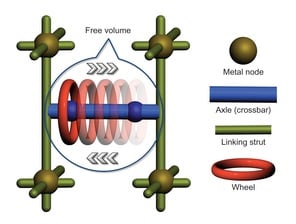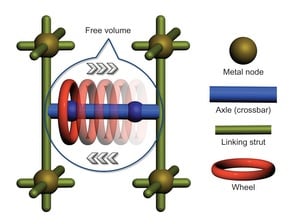
Two years ago we cited the demonstration by a group at the University of Windsor of a solid state molecular machine comprising a molecular wheel made from a rotaxane molecule held in place in a self-assembled metal organic framework. This work was widely recognized as a step toward solid state molecular machinery. A recent article at Phys.org written by Heather Zeiger explains the most recent step forward along that path, the creation of a molecular shuttle in which the ring around the axle of the rotaxane molecule shuttles back and forth between two positions. “Toward solid-state molecular circuitry: Molecular shuttle within a metal-organic framework“:
…Kelong Zhu, Christopher A. O’Keefe, V. Nicholas Vukotic, Robert W. Schurko and Stephen J. Loeb from the Department of Chemistry and Biochemistry at the University of Windsor have designed and characterized a molecular shuttle that functions both in solution and when placed within a rigid chemical structure called a metal-organic framework. Their work appears in Nature Chemistry [abstract].
This research makes use of the rotaxane architecture, a MIM [mechanically interlocked molecule] comprised of a ring-shaped molecule and two recognition sites. Rotaxanes have two components: A molecule is threaded through a macrocyclic ring, like a wheel with an axle. The macrocycle moves linearly along the axle between two recognition sites. Zhu, et al. used a 24-crown-8 macrocycle and benzimidazole recognition sites on the axle. …
The Phys.org article explains how this version of the molecular shuttle was tested both in solution and in a zinc-based metal organic framework, and worked in both solution and solid state environments, although much faster in solution (1.4 x 107 s-1 at 298 K) than in the crystalline environment (283 s-1 at 298 K). The conclusion:
… This research shows that molecular shuttles are feasible within a framework that restricts movement and flexibility of the [2]rotaxane axle, and restricts the distance between neighboring molecules, while still allowing for the translational movement of the shuttle. This provides a compelling case for the practical application of MIMs for molecular circuitry.
The stated goal of the Loeb Research Group is:
… If these tiny devices could be organized in a predictable and orderly manner, then the creation of ultra-dense molecular-based memory or controlling the electronic properties of materials at the molecular level would be very much closer to realization.
A quick glance at the Loeb Research Group publications page showcases the gradual development of molecular machines based on mechanically interlocked molecules organized inside metal organic frameworks over the two years since our previous citation of this work. It continues to be worth following to see where it leads.
—James Lewis, PhD
